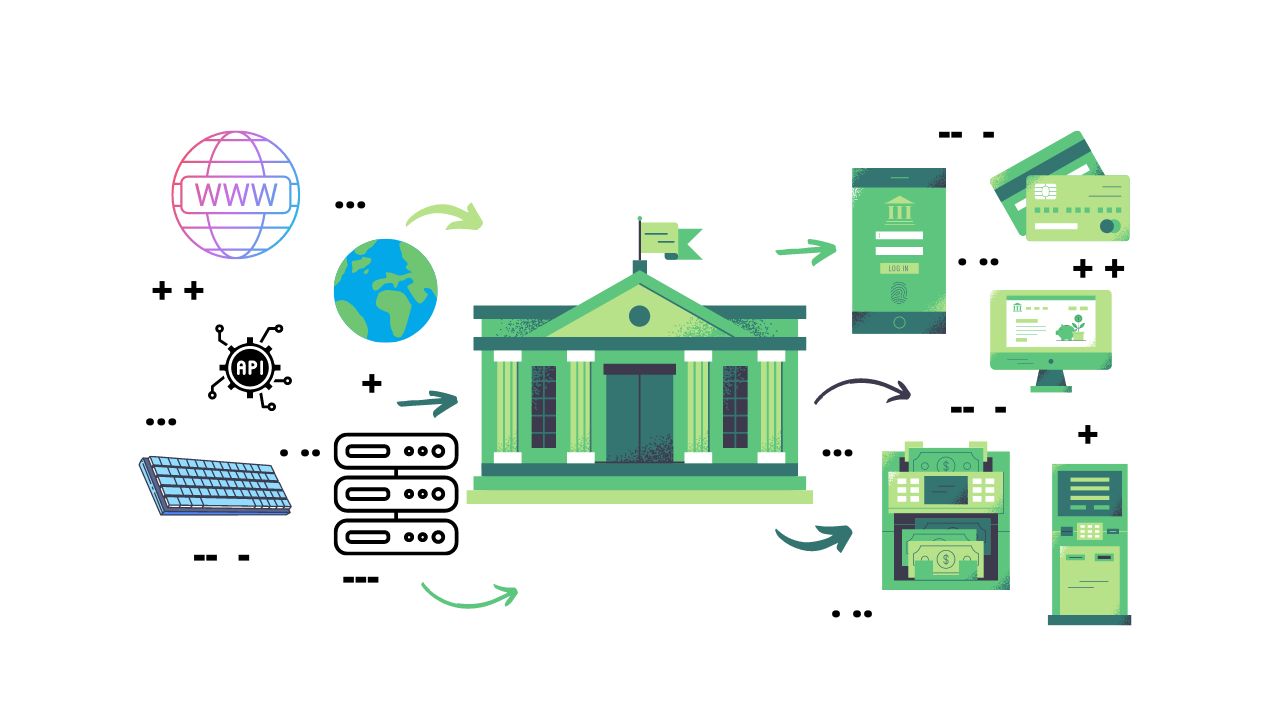Introduction
Welcome to the fascinating world of banking business! In this digital age, where financial transactions are conducted with just a few clicks, understanding the intricacies of the banking industry is more important than ever. Whether you’re depositing money, applying for a loan, or managing your investments, banks play a crucial role in our daily lives and the global economy.
At its core, banking business encompasses a range of activities related to the storage, management, and allocation of money. Banks serve as intermediaries, connecting those with surplus funds to those in need of capital. By providing a safe place to store money, offering loans, facilitating transactions, and guiding individuals and businesses in their financial endeavors, banks have become an indispensable element of modern society.
The functions of banks extend beyond mere transactional services. They foster economic growth by mobilizing savings, channeling funds into productive sectors, and facilitating investments. Banks also provide essential services such as electronic banking, mobile banking, and online payment systems, allowing customers to conveniently access and manage their funds.
There are different types of banks catering to specific needs and sectors. Commercial banks, which include retail banks, provide services to individuals and small businesses, such as checking accounts, savings accounts, and loans. Investment banks, on the other hand, focus on raising capital for corporations and assisting with mergers, acquisitions, and securities trading.
Central banks, such as the Federal Reserve in the United States, play a critical role in controlling monetary policy, regulating financial institutions, and managing the stability of the financial system. Cooperative banks, also known as credit unions, are member-owned and focus on serving specific communities or professions.
The banking business has numerous benefits for individuals and businesses. Access to banking services allows for secure storage of funds, convenient payment options, and access to credit. Banks also promote financial inclusion by offering services to unbanked populations, encouraging saving habits, and providing financial education.
Definition of Banking Business
The banking business can be defined as the industry that encompasses the activities of financial institutions, known as banks, which provide various financial services to individuals, businesses, and governments. These services include accepting deposits, lending money, facilitating transactions, managing investments, and offering other banking-related services.
Banks act as intermediaries between those who have surplus funds and those who need capital. They play a crucial role in the economy by taking deposits from individuals and institutions and using those funds to provide loans to borrowers. This process, known as the fractional reserve banking system, allows banks to create credit and stimulate economic growth.
One of the key functions of banks is to accept deposits from customers. This can be in the form of current accounts, savings accounts, fixed deposit accounts, or other types of accounts. Deposits provide individuals and businesses with a safe place to store their money while also allowing banks to utilize these funds for lending and other investment activities.
Lending is another vital aspect of banking business. Banks provide loans to individuals, businesses, and governments for various purposes, such as purchasing homes, starting or expanding businesses, or funding infrastructure projects. This function of banks helps stimulate economic activity, create employment opportunities, and support economic development.
In addition to deposits and lending, banks also facilitate transactions, both domestically and internationally. This includes providing services such as check clearing, electronic fund transfers, payment processing, and foreign exchange transactions. Banks are responsible for ensuring the security and efficiency of these transactions, allowing individuals and businesses to engage in commerce effectively.
Furthermore, banks play a crucial role in managing investments. They offer a range of investment products, such as mutual funds, stocks, bonds, and retirement accounts, allowing customers to grow their wealth and achieve their financial goals. Banks also provide advisory services to help individuals and businesses make informed investment decisions based on their risk tolerance and financial objectives.
Overall, the banking business is an essential component of the financial system. It provides vital services that facilitate economic growth, promote financial stability, and contribute to the well-being of individuals, businesses, and governments. As the financial landscape evolves, banks continue to adapt and innovate, leveraging technology to enhance their services and meet the changing needs of their customers.
Functions of Banks
Banks play a fundamental role in the economy by performing various functions that are vital for individuals, businesses, and governments. These functions can be broadly categorized into several key areas, including accepting deposits, lending money, facilitating transactions, managing investments, and offering other financial services.
One of the primary functions of banks is to accept deposits from individuals and institutions. By providing various types of accounts, such as savings accounts, current accounts, and fixed deposit accounts, banks offer a secure place for people to store their money. Deposits serve as the foundation of a bank’s lending activities and allow individuals to earn interest on their savings.
Lending is another essential function of banks. Banks provide loans to individuals, businesses, and governments to support various purposes, such as purchasing homes, starting or expanding businesses, and funding infrastructure projects. Through their lending activities, banks help stimulate economic growth, create job opportunities, and support investment activities.
In addition to accepting deposits and lending, banks facilitate domestic and international transactions. They provide services such as check clearing, electronic fund transfers, payment processing, and foreign exchange transactions. By ensuring the security and efficiency of these transactions, banks facilitate trade and enable individuals and businesses to engage in commercial activities effectively.
Banks also play a crucial role in managing investments. They offer a range of investment products, including mutual funds, stocks, bonds, and retirement accounts. Through these offerings, banks enable individuals and businesses to grow their wealth and achieve their financial goals. Moreover, banks provide investment advisory services to help customers make informed decisions based on their risk tolerance and financial objectives.
Apart from these core functions, banks offer a wide range of other financial services. This includes providing services such as insurance, wealth management, foreign currency exchange, and credit card facilities. Banks also serve as intermediaries in the capital markets by facilitating the trading of securities and providing underwriting and advisory services for corporate clients.
In summary, the functions of banks are essential for the smooth functioning of the economy. They accept deposits, lend money, facilitate transactions, manage investments, and offer a range of financial services. By performing these functions, banks contribute to economic growth, financial stability, and the well-being of individuals and businesses. As the financial landscape continues to evolve, banks are continually innovating to meet the changing needs of their customers and provide efficient and convenient financial solutions.
Types of Banks
The banking industry is diverse, consisting of different types of banks that cater to specific needs and sectors. While all banks share certain core functions, they also serve distinct purposes and operate under different regulations. Here are some of the main types of banks:
- Commercial Banks: Commercial banks are the most common type of banks that we encounter in our daily lives. They provide a wide range of services to individuals and businesses, including checking and savings accounts, loans, credit facilities, and payment processing. Commercial banks play a crucial role in mobilizing deposits and channeling funds into the economy through lending activities.
- Investment Banks: Investment banks focus on providing services to corporations and institutional clients. They assist in raising capital through activities like underwriting securities, facilitating mergers and acquisitions, and advising on corporate finance strategies. Investment banks are often involved in complex financial transactions and play a significant role in the capital markets.
- Central Banks: Central banks are responsible for formulating and implementing monetary policy, regulating financial institutions, and maintaining the stability of the financial system. They are typically government-owned and independent entities. Central banks have the authority to issue and regulate currency, manage interest rates, and act as lenders of last resort to commercial banks in times of financial stress.
- Cooperative Banks: Cooperative banks, also known as credit unions, are member-owned financial institutions. They are formed by a group of individuals or communities who share a common bond, such as a profession or geographical area. Cooperative banks provide banking services tailored to the needs of their members, often with a focus on financial inclusion and community development.
Each type of bank operates under specific regulations and serves distinct purposes in the financial ecosystem. Commercial banks offer everyday banking services to individuals and businesses, while investment banks specialize in corporate finance and capital markets. Central banks hold responsibilities for monetary policy and financial stability, and cooperative banks prioritize the needs of their member communities.
It is important to note that these types of banks are not mutually exclusive, and many banks may offer a combination of services from different categories. For example, some commercial banks have investment banking divisions, and some cooperative banks may offer commercial banking services. The distinctions among these types of banks help to ensure that diverse financial needs are met and that the banking sector effectively supports the needs of the economy and society.
Commercial Banks
Commercial banks are the most common and widely recognized type of banks, serving as the primary interface between individuals, businesses, and the banking system. They play a critical role in the economy by providing a range of financial services to meet the diverse needs of customers.
One of the main functions of commercial banks is to accept deposits from individuals, businesses, and other institutions. Customers can open various types of accounts, such as checking accounts, savings accounts, and certificates of deposits. By depositing funds in these accounts, individuals and businesses can safely store their money while earning interest on their deposits.
In addition to deposit services, commercial banks offer a variety of lending products. They provide loans to individuals and businesses for different purposes, including personal loans, home mortgages, and business loans. Commercial banks evaluate the creditworthiness of borrowers and assess the risk associated with each loan. Through their lending activities, commercial banks stimulate economic growth by supporting investment and consumption.
Commercial banks also play a significant role in providing payment services and facilitating transactions. They issue debit and credit cards, process electronic fund transfers, and provide services for check clearing and payment processing. By ensuring the efficiency and security of transactions, commercial banks facilitate the smooth functioning of the financial system and enable individuals and businesses to make payments conveniently.
Commercial banks often offer additional financial services, such as foreign currency exchange, wealth management, investment advisory services, and insurance products. These services allow customers to access a comprehensive range of financial solutions and manage their assets effectively. Commercial banks may also provide specialized services for small businesses, such as business accounts, lines of credit, and merchant services.
Regulation and supervision of commercial banks are typically carried out by government authorities to ensure stability and protect the interests of depositors. Banks are subject to strict regulatory standards, including capital requirements, reserve ratios, and reporting obligations. Regular audits and supervision by banking regulators help maintain the integrity and soundness of the banking system.
Overall, commercial banks are vital institutions in the financial landscape, serving as intermediaries between savers and borrowers. They provide a wide range of services, including deposit taking, lending, payment processing, and additional financial solutions. With their extensive networks and expertise, commercial banks contribute to economic growth, financial inclusion, and the overall stability of the financial system.
Investment Banks
Investment banks are a specialized type of financial institution that focus on providing various services to corporations, institutional clients, and governments. They play a critical role in the capital markets by assisting in raising capital, facilitating mergers and acquisitions, and providing advisory services related to corporate finance and investments.
One of the primary functions of investment banks is underwriting securities. When a company wants to raise capital by issuing stocks or bonds, investment banks act as intermediaries between the company and investors. They help structure the offering, assess the value of the securities, and then buy the securities from the issuer to sell them to investors. This process helps companies access the capital they need to fund their operations and expansion.
Investment banks also provide mergers and acquisitions (M&A) advisory services. They assist companies in strategic transactions such as mergers, acquisitions, and divestitures. Investment banks provide expertise in deal negotiation, valuation, due diligence, and transaction structuring. They help facilitate these complex transactions and ensure that the interests of the stakeholders involved are protected.
Beyond underwriting and M&A services, investment banks offer advisory services related to corporate finance and investments. They provide guidance to corporations on capital management, strategic planning, and financial restructuring. Investment banks also offer insights and analysis on market trends, investment opportunities, and risk management strategies to institutional clients and high-net-worth individuals.
Investment banks are actively involved in trading securities and managing their clients’ investment portfolios. They engage in activities such as market-making, where they buy and sell securities on behalf of clients, and proprietary trading, where they trade financial instruments with their own capital. These activities enable investment banks to generate revenue from price differentials and market fluctuations.
Additionally, investment banks provide research services to institutional investors, offering analysis and recommendations on stocks, bonds, and other financial instruments. This research helps investors make informed investment decisions and manage their portfolios effectively.
Investment banks operate in a highly regulated environment, subject to specific regulations and oversight. They must comply with regulations related to securities trading, capital adequacy, client protection, and disclosure requirements. Supervisory authorities monitor their activities to maintain market integrity and safeguard the interests of investors.
In summary, investment banks serve as intermediaries in the capital markets, specializing in services such as underwriting securities, M&A advisory, corporate finance, and investment management. Through their expertise and extensive networks, investment banks facilitate capital raising, strategic transactions, and investment activities. They play a crucial role in driving economic growth, fostering innovation, and contributing to the functioning of the global financial system.
Central Banks
Central banks are key institutions in the financial system that play a critical role in maintaining stability, controlling monetary policy, and regulating financial institutions. They act as the backbone of the economy by overseeing the supply of money, managing interest rates, and ensuring the stability of the financial system as a whole.
One of the primary functions of central banks is to formulate and implement monetary policy. Central banks have the authority to control the money supply and manage interest rates in order to influence economic growth, maintain price stability, and achieve financial stability. They use tools such as open market operations, reserve requirements, and lending facilities to manage liquidity in the banking system and influence borrowing costs.
Central banks also act as the lender of last resort in times of financial stress. They provide emergency liquidity to banks and other financial institutions to prevent systemic crises and maintain the stability of the financial system. This function ensures the smooth functioning of the banking system and helps restore confidence in times of economic turmoil.
Regulating and supervising financial institutions is another key responsibility of central banks. They establish and enforce prudential regulations and guidelines to ensure the safety and soundness of banks and other financial institutions. Central banks monitor the activities of financial institutions, conduct regular audits, and assess their risk management practices to prevent excessive risk-taking and maintain financial stability.
Central banks also play a role in managing the foreign exchange reserves of the country. They intervene in the foreign exchange markets to stabilize the currency and maintain a favorable exchange rate. Central banks may engage in buying or selling foreign currencies to influence the value of the domestic currency, ensuring stability in international trade and cross-border transactions.
In addition to their regulatory and monetary functions, central banks often serve as advisors to the government and provide economic analysis and forecasts. They offer insights into economic conditions, inflation trends, and fiscal policy implications. Central banks act as independent entities, enabling them to make objective policy decisions based on economic data and analysis.
Central banks are typically government-owned, but they operate with a certain degree of independence to ensure impartial decision-making and insulate monetary policy from political interference. They are accountable to the government and the public, frequently communicating their policy decisions and providing transparency in their operations.
In summary, central banks are crucial institutions that control monetary policy, regulate financial institutions, and ensure the stability of the financial system. Through their actions, they aim to promote stable economic growth, maintain price stability, and safeguard the integrity of the financial system. Central banks play an essential role in shaping the national and global economy and contribute to the overall well-being of society.
Cooperative Banks
Cooperative banks, also known as credit unions, are unique financial institutions that are owned and operated by their members. They provide banking services tailored to the specific needs of their members and are guided by the principles of cooperation and mutual assistance.
One of the distinguishing features of cooperative banks is their ownership structure. Unlike commercial banks that are owned by shareholders, cooperative banks are owned by their depositors and borrowers. Members of a cooperative bank elect a board of directors who are responsible for making strategic decisions and ensuring the best interests of the members are served.
Cooperative banks offer a range of financial services to their members, including savings accounts, current accounts, loans, and other banking products. They generally focus on serving a specific community or profession, such as teachers, farmers, or employees of a particular organization. By operating within a close-knit community, cooperative banks can better understand the needs of their members and provide personalized services.
In addition to traditional banking services, cooperative banks often emphasize financial inclusion and community development. They aim to empower their members by providing access to affordable financial products and services, promoting savings habits, and offering financial education. Cooperative banks prioritize the financial well-being of their members and contribute to the economic development of the communities they serve.
As member-owned institutions, cooperative banks place a strong emphasis on customer satisfaction and member participation. Unlike commercial banks that focus on maximizing profits for shareholders, cooperative banks aim to benefit their members. This can result in lower fees and more competitive rates for loans and deposits, as well as a greater emphasis on customer service and building long-term relationships with members.
Cooperative banks also foster a sense of community and solidarity among their members. Members often have a say in the decision-making process through voting rights and participation in annual general meetings. This democratic governance structure ensures that the interests of the members are represented and that the bank remains accountable to its members.
Regulation and supervision of cooperative banks vary by jurisdiction, but they are generally subject to specific regulations aimed at protecting the interests of members and maintaining financial stability. Governments often have dedicated frameworks in place to oversee the operations and governance of cooperative banks, ensuring compliance with regulatory standards.
Overall, cooperative banks serve as important pillars for community finance and social development. They contribute to financial inclusion, promote community participation, and provide tailored financial services to their members. Cooperative banks foster a sense of ownership and solidarity while prioritizing the needs and interests of their members, creating a unique and customer-centric banking experience.
Benefits of Banking Business
The banking business offers numerous benefits that positively impact individuals, businesses, and the economy as a whole. By providing a range of financial services, banks play a vital role in facilitating economic growth, promoting financial security, and improving overall well-being. Here are some of the key benefits of banking business:
- Safe Storage of Funds: Banks offer a secure place for individuals and businesses to store their money. Insured deposits provide protection against theft, loss, and other risks associated with keeping cash at home or in less secure environments.
- Convenient Payment Solutions: Banks provide various payment options, such as debit cards, credit cards, electronic transfers, and online payment platforms. These services allow for quick and convenient transactions, making it easier for individuals and businesses to manage their finances.
- Access to Credit: Banks offer loans and credit facilities to individuals, businesses, and governments. Access to credit enables individuals to fulfill their dreams, such as purchasing a home or starting a business. For businesses, loans provide vital capital for expansion and investment in new projects.
- Wealth Management and Investment Opportunities: Banks provide a range of investment products and wealth management services to help individuals grow their wealth and meet their financial goals. These offerings include savings and investment accounts, mutual funds, retirement plans, and investment advisory services.
- Financial Inclusion: Banks promote financial inclusion by reaching out to unbanked and underbanked populations. They offer basic banking services to individuals who may not have access to traditional financial institutions, helping them build financial stability and participate in the formal economy.
- Financial Education: Banks often provide financial education programs and resources to help individuals and businesses make informed financial decisions. These initiatives can improve financial literacy, empower individuals to manage their finances effectively, and promote responsible borrowing and saving habits.
- Economic Stimulus: Banks play a crucial role in driving economic growth by mobilizing savings and channeling funds into productive sectors. Through lending activities, they provide capital to individuals and businesses, which stimulates consumption, investment, and job creation.
- Support for International Trade: Banks facilitate international trade by providing trade finance services such as letters of credit and documentary collections. These services help reduce risk in cross-border transactions, enabling businesses to engage in global commerce with confidence.
- Technological Advancements: Banks are at the forefront of adopting and developing new technologies that enhance their services, such as online banking, mobile banking apps, and digital payment solutions. These innovations improve convenience, efficiency, and accessibility for customers.
In summary, the banking business offers a wide range of benefits that contribute to financial security, economic growth, and overall prosperity. From safe storage of funds to convenient payment solutions, access to credit, and wealth management opportunities, banks play a crucial role in meeting the diverse financial needs of individuals and businesses. Through their services and initiatives, banks promote financial inclusion, foster economic development, and improve the financial well-being of their customers and society as a whole.
Importance of Banking Business in the Economy
The banking business plays a pivotal role in the economy, acting as a catalyst for growth, stability, and overall financial well-being. The importance of banking business in the economy can be understood by examining its various contributions and functions:
- Financial Intermediation: Banks serve as intermediaries between those with surplus funds and those in need of capital. They mobilize savings from individuals and institutions and effectively allocate these funds through lending and investment activities. By bridging the gap between savers and borrowers, banks facilitate the flow of funds in the economy, fostering investment, entrepreneurship, and economic growth.
- Capital Formation: Through their lending activities, banks play a critical role in capital formation. They provide loans to businesses and individuals for various purposes, such as starting or expanding businesses, purchasing homes, and funding infrastructure projects. The availability of credit fuels economic activities, job creation, and overall development.
- Payment System Efficiency: Banks provide a reliable and efficient payment infrastructure that facilitates the smooth conduct of economic transactions. Through services such as check clearing, electronic fund transfers, and online payment platforms, banks ensure the safe and timely settlement of payments, promoting business transactions, trade, and commerce.
- Financial Stability: Banks contribute to financial stability by acting as custodians of public funds and ensuring the integrity of the financial system. They maintain reserves, adhere to strict regulatory standards, and are subject to rigorous oversight. Central banks, in particular, play a crucial role in monitoring financial institutions, managing risks, and controlling monetary policy to maintain the stability of the overall economy.
- Facilitating International Trade: Banks facilitate international trade by providing trade finance services such as letters of credit, international fund transfers, and foreign exchange services. These services mitigate the risks associated with cross-border transactions, promote the flow of goods and services, and support global economic integration.
- Encouraging Saving and Investment: Banks offer various savings and investment products that incentivize individuals and businesses to save and invest their money. These financial solutions provide a secure means of holding and growing wealth, promoting long-term financial planning, and supporting economic stability.
- Job Creation and Economic Growth: The banking industry itself is a significant contributor to employment and economic growth. Banks create job opportunities directly through their workforce and indirectly by providing financial resources to businesses that drive job creation. The expansion of the banking sector contributes to overall economic development and prosperity.
- Promoting Financial Inclusion: Banks play a crucial role in promoting financial inclusion by providing banking services to underserved communities and unbanked populations. By offering accessible and affordable financial products and services, they help individuals and businesses participate in the formal financial system, create economic opportunities, and reduce income inequality.
In summary, the importance of the banking business in the economy cannot be overstated. Through financial intermediation, capital formation, efficient payment systems, and support for international trade, banks foster economic growth, stability, and financial inclusion. They enable access to credit, promote saving and investment, and contribute to job creation. The banking business acts as a backbone of the economy, supporting individuals, businesses, and governments in their pursuit of financial security, prosperity, and overall economic well-being.
Challenges in the Banking Business
The banking business operates in a dynamic and complex environment, facing various challenges that impact its operations, profitability, and reputation. These challenges arise from factors such as technological advancements, regulatory changes, market competition, and economic uncertainties. Here are some of the key challenges in the banking business:
- Digital Transformation: Rapid technological advancements and changing customer expectations have necessitated the adoption of digital platforms and services. Banks face challenges in implementing digital transformation strategies, ensuring cybersecurity, and providing seamless customer experiences across multiple channels.
- Regulatory Compliance: Banks operate in a highly regulated environment and must navigate complex and evolving regulatory requirements. Compliance with regulatory standards, reporting obligations, and risk management frameworks poses challenges in terms of resources, costs, and adaptability to changing regulatory landscapes.
- Cybersecurity: With the increasing prevalence of cyber threats, banks face constant challenges in safeguarding their systems, data, and customer information from cyberattacks. Developing robust cybersecurity measures, investing in advanced technologies, and educating employees and customers about cybersecurity risks are ongoing challenges for banks.
- Market Competition: The banking industry is highly competitive, with traditional banks facing increasing competition from fintech companies, payment processors, and other non-banking entities. Banks need to innovate, differentiate their offerings, and enhance customer experiences to stay competitive in the market.
- Low Interest Rate Environment: The prolonged low-interest-rate environment poses profitability challenges for banks. Reduced net interest margins, coupled with increased competition and regulatory costs, put pressure on banks’ profitability and their ability to generate sufficient returns.
- Economic and Financial Volatility: Banks operate within the wider economic environment, making them susceptible to economic cycles, financial market volatility, and geopolitical risks. Economic uncertainties, such as recessions or financial crises, can impact asset quality, loan defaults, liquidity, and overall stability of banking operations.
- Changing Customer Expectations: Customers’ expectations regarding banking services have evolved, driven by technological advancements and enhanced digital experiences. Banks need to address changing customer preferences, offer personalized and convenient services, and provide seamless omni-channel experiences to meet customer expectations.
- Risk Management: Effective risk management is essential for banks to mitigate various risks, including credit risk, market risk, and operational risk. Developing robust risk management frameworks, enhancing risk assessment capabilities, and building effective risk culture pose challenges in an ever-changing and interconnected business landscape.
- Legacy Systems and Infrastructure: Several banks still rely on legacy systems and outdated infrastructure, making them less agile and less capable of adopting new technologies and meeting customer demands efficiently. Upgrading systems, integrating new technologies, and ensuring interoperability between different systems pose challenges for banks.
In summary, the banking business faces numerous challenges that require constant adaptation, innovation, and risk management. From digital transformation and regulatory compliance to cybersecurity threats and market competition, banks must navigate an ever-changing landscape to ensure sustainability and success. Overcoming these challenges requires strategic planning, effective resource allocation, strong risk management, and a customer-centric approach.
Future of Banking Business
The banking business is poised for significant transformation in the coming years as it adapts to emerging trends, technological advancements, and evolving customer expectations. Several key factors will shape the future of banking, including the following:
- Digitalization and Artificial Intelligence: The future of banking will be characterized by increased digitalization and the use of artificial intelligence (AI) technologies. Banks will leverage AI-powered chatbots, machine learning algorithms, and data analytics to enhance customer experiences, automate processes, and deliver personalized financial solutions.
- Fintech Disruption: The rise of fintech companies and innovative startups will continue to disrupt traditional banking models. Banks will embrace collaboration with fintech firms, exploring partnerships, and adopting technologies that enable them to offer competitive and innovative products and services.
- Open Banking: Open banking, driven by regulatory initiatives and customer demands for more control over their financial data, will shape the future of banking. Banks will leverage Application Programming Interfaces (APIs), enabling secure data sharing and developing ecosystems of interconnected financial services to offer customers greater flexibility and choice.
- Enhanced Customer Experience: Customer-centricity will remain a major focus for banks in the future. Banks will invest in improving customer experience through user-friendly interfaces, personalized recommendations, faster transaction processing, and seamless integration across multiple channels.
- Regulatory Changes: Banks will continue to navigate a changing regulatory landscape. Regulations such as the Payment Services Directive 2 (PSD2), General Data Protection Regulation (GDPR), and anti-money laundering protocols will shape how banks operate, ensuring transparency, data protection, and fair practices.
- Increased Focus on Cybersecurity: With the growing threat of cyberattacks, banks will prioritize cybersecurity and invest in robust infrastructure, threat detection, and data protection measures. Enhanced security protocols, biometric authentication, and AI-driven fraud detection will become standard in banking operations.
- Expanding Financial Inclusion: Banks will continue to address the challenge of financial inclusion by leveraging technology to reach unbanked populations. Mobile banking, digital wallets, and innovative solutions will enable greater access to financial services, bridging the gap and promoting financial well-being for underbanked communities globally.
- Environmental, Social, and Governance (ESG) Focus: Banks will increasingly incorporate ESG considerations into their operations. They will develop sustainable financing solutions, promote responsible investments, and align their business practices with environmental and social goals.
- Mergers, Acquisitions, and Consolidation: The banking industry may witness increased consolidation as banks seek to achieve economies of scale, strengthen their market position, and leverage synergies arising from mergers and acquisitions. This trend is expected to continue as banks look to adapt to evolving customer needs and enhance their competitiveness.
In summary, the future of banking will be characterized by digitalization, collaboration with fintech firms, enhanced customer experiences, and continued regulatory changes. With advancements in technology, increased focus on cybersecurity, and a commitment to financial inclusion and sustainability, banks are well-positioned to adapt and thrive in the rapidly evolving financial landscape.
Conclusion
The banking business is a vital component of the global economy, playing a crucial role in facilitating financial transactions, providing credit, and promoting economic growth. Through various functions such as accepting deposits, lending money, facilitating transactions, managing investments, and offering other financial services, banks contribute to the stability, development, and well-being of individuals, businesses, and governments.
As we look to the future, the banking industry is poised for significant change. Digital transformation, fintech disruption, open banking, and customer-centricity are some of the key trends that will shape the future of banking. Technology, such as artificial intelligence, will drive innovation, enhance efficiency, and deliver personalized financial solutions. Customer experience will remain a top priority, with banks focusing on convenience, personalization, and seamless integration across channels.
Regulatory changes and cybersecurity will continue to pose challenges in the banking business. Banks will need to navigate complex regulatory landscapes, ensure compliance, and protect themselves and their customers from cyber threats. Financial inclusion will also be a central focus, with banks striving to reach unbanked populations and provide access to affordable financial services.
Despite the challenges, the banking business is well-positioned to adapt and thrive. Through collaboration with fintech companies, adoption of new technologies, and innovative product offerings, banks can enhance their competitiveness and meet the evolving needs of customers. Continued focus on sustainability, responsible investing, and ESG considerations will ensure the banking industry plays a positive role in societal and environmental progress.
In conclusion, the banking business remains a vital component of the global economy, providing essential financial services to individuals, businesses, and governments. With the ever-evolving landscape of technology, regulations, and customer expectations, banks must continue to innovate, embrace change and adapt to meet the needs of a dynamic and interconnected world.

























